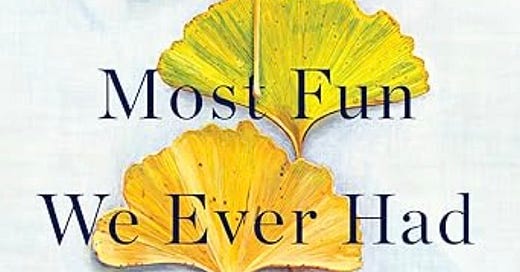BookLife Review by Carol O’Day: The Most Fun We Ever Had (Claire Lombardo, author)
Family saga, family secrets, marriage, motherhood, sisterhood, four siblings, closed adoption, foster care, mental illness, stillbirth, birth parents.
Claire Lombardo’s family saga, The Most Fun We Ever Had, is a satisfying novel about the multi-decade marriage of Marilyn and David Sorensen and their four daughters. Lombardo marinates a stew of the similarities and differences between and among the four distinct children–their sibling rivalries, and the unassailable loyalty inherent in sisterhood, as well as the shared and gradient experiences of sisters who differ despite growing up with the same set of parents. The bonds between parent and each child and those between sisters are challenged and tested when a long-held family secret rips through the fabric of the family.
The love story of Marilyn and David sets both a rare, aspirational and arguably unattainable standard for coupledom for their four daughters. Yet, Lombardo shows the reader at every turn that the couple’s relationship is not idyllic but rather is ferociously pedestrian; it is the happy product of hard work and a relationship ethic that actively chooses daily, over and over again, to protect, defend and sustain their marriage with whatever sacrifices it may require.
David Sorensen and Marilyn Connolly meet in college, where David is pre-med and Marilyn is studying English literature. They enjoy an immediate and passionate connection. They marry and move from Chicago to Iowa for David’s medical school and residency training. Marilyn enrolls in college but pregnancy sidelines her college plans; she withdraws from school to raise their first daughter, Wendy. The second pregnancy comes unexpectedly fast on the heels of the first, almost burying Marilyn in depression, regret and exhaustion. Though new arrival, Violet, is a placid baby, Wendy is stormy. Marilyn loves motherhood, but the circumstances of David’s training and their location in Iowa leave her lonely and overwhelmed. On and off during the marriage, Marilyn ruminates on and regrets her decision to quit college; she battles against her periodic resentment of David that their decisions and her resulting role as an at-home mother trigger. After a longer interval, third daughter Liza is born. Not long after, Marilyn’s father dies. He leaves his only child his large home in the suburbs west of Chicago, and they move back to Marilyn’s spacious childhood home. As their three daughters reach preadolescence and adolescence, the couple decides to have a fourth child. They believe the odds are on having a boy, and are surprised by the arrival of another daughter, Grace.
First-born Wendy’s demons include a percolating rage. She turns to sexual promiscuity, drugs and alcohol to soothe herself, leading her to an eating disorder and a near overdose as a teen. Number two daughter Violet is the overachieving rule-follower, but she is derailed by a college pregnancy, and elects (with then-married Wendy’s assistance) to have the baby secretly and place him for adoption. After college, Liza embarks in a relationship with a partner who experiences clinical depression. Liza becomes pregnant, is unfaithful to Ryan and Ryan leaves her to face single motherhood. Grace, affectionately nicknamed as Marilyn and David’s “Epilogue,” lives in a universe of her own, having not shared many of her sisters’ childhood experiences. She escapes to the West Coast but struggles to find direction. The family’s complex dynamic is upended when Violet’s adopted son, Jonah, surfaces as a 15 year-old. Jonah was orphaned by the early death of his adoptive parents and placed in foster care.
This multi-decade family story is crafted with plentiful twists. Its chapters are told each through the point of view of a different member of the family. Through this structure, the reader gets to know teach member of the family. Lombard’s particular gift is her ability to show, through their actions and interactions, the love that flows between the sisters and from the parents to each daughter. This abiding love fills the cracks that inevitably surface in their lives.
There is a delicious, almost rhythmic ebb and flow to the story. The reader witnesses the march of time through the growth, regression, conflict and resolution of each character. Wendy’s pain (of unclear origin) triggers our empathy. The depth and enormity of Ryan’s mental illness begs us to root for Liza. Violet’s repressed heartache over her surrendered child not only spurs her perfectionism and overachieving, but causes her to hold Jonah at emotional distance; the reader cools on Violet as a result, for a considerable portion of the novel. Grace’s struggle to launch, as the coddled youngest of four, is relatable to anyone in a large family. Privy to Marilyn’s struggles in ways that their daughters are not, the reader tracks her decades long marriage to David with both trepidation and admiration. She overcomes her resentments, does her best to love each of her daughters fully and equally, and rediscovers herself when they grow and leave, only to begin again with Jonah in her home. Laugh, cry, cheer and fret for the Sorensen family, and revel in Lombardo’s ability to conjure up the joy that family can deliver to assuage any manner of heartache.
Please support BookLife: Reviews for Readers and independent book sellers by purchasing The Most Fun We Ever Had through Bookshop.org using the link below.
Purchase The Most Fun We Ever Had here.
For more book reviews and writing by Carol O’Day visit BookLife; Reviews for Readers on Substack.





